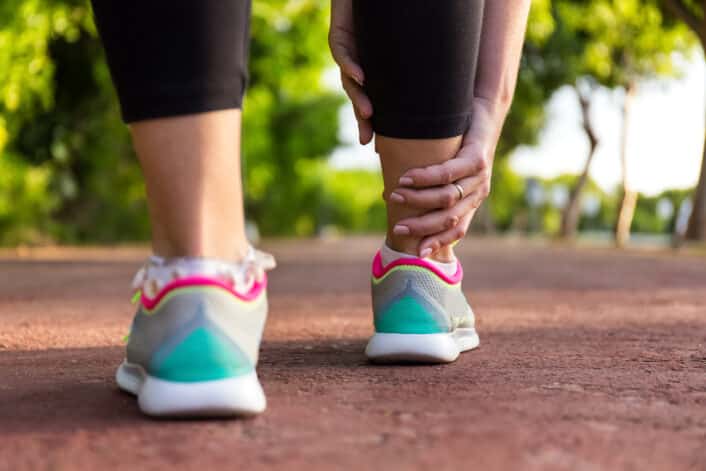Disclaimer: This article is for informational purposes only and is not intended for diagnostic use. LifeDNA does not provide diagnostic reports on any traits discussed. Genetics is just one piece of the puzzle; please consult a healthcare professional for comprehensive guidance on any health condition.
Achilles tendinopathy doesn’t always come on suddenly. It usually develops over time from repeated stress on the tendon, such as running on hills, wearing the wrong shoes, or skipping your stretches. You might not notice it at first, but over time, the stiffness and swelling can interfere with even simple activities like walking or climbing stairs.
This slow build-up often means people delay getting help, risking more serious injury down the line. That’s why knowing the early symptoms, risk factors, and treatment options is key. Whether you’re dealing with mild irritation or more intense pain, it’s important to take action before the condition progresses. Early recognition and proper care can make a big difference in recovery time and long-term tendon health.
What is Achilles Tendinopathy?
Achilles tendinopathy is an injury of the overuse of the Achilles tendon. It most commonly occurs in runners who suddenly increase their intensity or distance, and in middle-aged people who engage in vigorous sports such as tennis or basketball on weekends. But even those who aren’t athletes may develop this condition due to everyday strain or other contributing factors.
This condition is marked by degeneration or small tears in the tendon caused by repetitive stress or mechanical overload. As we age, the Achilles tendon becomes less flexible and more prone to injury, especially if physical activity levels suddenly change.
What Are The Symptoms of Achilles Tendinopathy?
Achilles tendinopathy usually develops gradually and is possible to worsen over time if left untreated. Here are some symptoms:
- Pain or stiffness in the back of the leg or above the heel, especially after physical activity
This is often an early sign of tendon strain. The pain typically starts as a dull ache that becomes more noticeable after walking, running, or standing for long periods. It happens because the tendon has been overworked and is starting to show signs of irritation or small tears. - Tenderness and swelling around the tendon
The area around the Achilles tendon may feel sore to the touch, and swelling can appear as the body reacts to inflammation. Swelling is usually more noticeable after activity and may come with a warm sensation. - A mild ache that becomes more severe after climbing stairs or sprinting
Movements that require quick, forceful actions like sprinting or going up stairs place extra pressure on the Achilles tendon. If the tendon is irritated, these activities can make the pain sharper and more intense. - Morning stiffness that improves with movement
Many people with Achilles tendinopathy feel a tight or stiff sensation in the back of the leg when they first wake up. This stiffness is due to reduced circulation and inactivity overnight. The discomfort usually fades after a few minutes of walking or stretching. - Difficulty walking
As the condition worsens, pain may interfere with normal walking. Even standing may become uncomfortable, especially if the tendon is inflamed or structurally weakened. - A visible lump or nodule may form on the tendon in severe cases
Long-term stress on the tendon can cause it to thicken or develop small, hard nodules. These lumps are a result of scar tissue forming in response to repeated injury and can make the tendon feel uneven or bumpy. - A sudden, sharp pain that feels like being hit in the back of the heel may indicate a tendon rupture
This is a serious symptom and may mean the tendon has torn. People often describe the feeling as if someone kicked them in the back of the ankle. It is typically followed by weakness, swelling, and difficulty using the foot. A rupture requires immediate medical attention and often surgical repair.
What Are The Degrees of Severity of Achilles Tendinopathy?
Achilles tendinopathy can range from mild discomfort to serious tendon damage. Understanding the level of severity can help guide treatment and prevent further injury.
- Mild: At this stage, pain is usually felt during or shortly after specific physical activities, such as running or jumping. The discomfort often goes away with rest and might not interfere with daily tasks. However, this is an early sign that the tendon is being overworked and needs attention.
- Moderate: As the condition progresses, the pain becomes more noticeable and may be accompanied by visible swelling around the tendon. In some cases, a small, hard lump—or nodule—can develop within the tendon itself. This lump is a sign of ongoing degeneration and scarring inside the tendon tissue.
- Severe: At its most serious stage, pain is present even during simple weight-bearing activities like walking or standing. The discomfort can be constant and may limit daily movement. In rare cases, the tendon may partially or completely rupture, causing sudden, intense pain and requiring urgent medical treatment.
What Causes Achilles Tendinopathy?
Achilles tendinopathy can develop from a variety of physical, medical, and lifestyle-related factors. These causes often work together to put stress on the Achilles tendon over time.
- Overuse or repetitive strain: Activities like running, jumping, or sudden increases in physical training can overload the tendon. This repeated stress can lead to tiny tears and long-term wear.
- Age-related wear and tear: As people get older, the structure of the Achilles tendon naturally weakens. This makes it more prone to injury, especially in those who are active only occasionally.
- Foot structure issues: Flat feet or feet that roll inward too much (a condition called hyperpronation) can place added strain on the Achilles tendon. These structural problems affect how forces travel through the foot and ankle during movement.
- Tight calf muscles: If the calf muscles are not flexible, they limit ankle motion and increase tension on the tendon. This can contribute to pain and inflammation over time.
- Improper footwear: Shoes that don’t offer enough support, especially if they are worn out, can affect how forces are absorbed during walking or running. Wearing high heels frequently can also shorten the Achilles tendon, reducing flexibility and increasing injury risk.
- Obesity: Carrying excess weight increases the load placed on the tendon, particularly during walking, climbing stairs, or exercising.
- Medical conditions: Certain health conditions, such as inflammatory arthritis, psoriasis, and high blood pressure, have been linked to tendon issues, possibly due to inflammation or reduced blood flow.
- Cold weather: Tendons tend to be stiffer in cold environments, which may reduce their flexibility and increase the risk of injury during activity.
- Sudden changes in training: Rapidly increasing the intensity, duration, or difficulty of physical training may overload the tendon before it has time to adapt.
Genetics on Achilles Tendinopathy
Studies have found specific genetic markers that may affect tendon strength, flexibility, and repair. One key gene, COL5A1, is involved in collagen formation, a protein essential for tendon structure and strength. Variants in this gene can lead to tendons that are less flexible, which increases the risk of injury when subjected to physical stress. This gene’s influence on tendon properties makes it a significant area of research for tendon injuries.
In addition to COL5A1, other genes like COL1A1, MMP3, and TNC have been linked to tendon health. COL1A1 is important for tendon strength, helping to form collagen type I, while MMP3 plays a role in tendon repair, influencing how tendons heal after injury. TNC, which codes for Tenascin-C, is involved in how tendons respond to strain, and variations in this gene, especially the number of GT repeats have been shown to contribute to the likelihood of tendon injury. These genetic differences may also affect the rate at which tendons heal, and some variations may slow down the healing process or lead to tendon degeneration over time.
While more research is needed to fully understand how these genes and their variants interact, it’s clear that genetic testing in the future could help identify individuals at higher risk for tendon injuries. Understanding how these genes influence tendon health could eventually help predict and prevent Achilles tendon injuries, offering a path to more personalized prevention strategies.
How is Achilles Tendinopathy Diagnosed?
Diagnosing Achilles tendinopathy typically involves a combination of questions, physical examination, and in some cases, imaging or lab tests. A doctor or physiotherapist will carefully assess several aspects of your health and symptoms to confirm the diagnosis.
- Medical history and physical activity habits: Your healthcare provider will start by asking about your symptoms, medical history, and physical activity. Understanding how long you’ve had the pain, what activities make it worse, and whether there have been any changes in your exercise routine can help identify the underlying cause.
- Physical examination: During the physical exam, the provider will check for tenderness, swelling, or thickening of the tendon. They may gently press on the Achilles tendon to locate the pain and assess the range of motion in your ankle. Observing how you walk or stand on your toes can also provide important clues.
- Imaging tests: Depending on the severity of the symptoms, imaging may be used to get a clearer look at the tendon. X-rays can help rule out bone problems, while ultrasound and MRI scans offer detailed images of soft tissues, helping to detect tendon thickening, small tears, or inflammation.
- Blood tests: If there is a possibility that an underlying inflammatory condition—like rheumatoid arthritis or another autoimmune issue—is contributing to the tendon pain, blood tests may be recommended to check for markers of inflammation or immune activity.
What Are The Treatment Options for Achilles Tendinopathy?
Most cases of Achilles tendinopathy improve with non-surgical treatment, especially when managed early. A combination of lifestyle changes, therapies, and supportive care is usually effective in relieving pain and restoring function.
- Rest and activity modification: Reducing or avoiding high-impact activities like running, jumping, or climbing stairs gives the tendon time to heal. Switching to low-impact exercises such as swimming or cycling can help maintain fitness without overloading the tendon.
- Ice therapy: Applying ice packs to the affected area for about 20 minutes at a time during acute flare-ups can help reduce inflammation and ease discomfort. This is especially helpful after physical activity or at the end of the day.
- Anti-inflammatory medications: Short-term use of nonsteroidal anti-inflammatory drugs (NSAIDs), such as ibuprofen or naproxen, may help reduce pain and swelling. However, they should be used with caution and under a doctor’s guidance.
- Physical therapy: A physiotherapist can guide you through specific exercises that focus on stretching and strengthening the calf muscles and Achilles tendon. Eccentric loading exercises—where the tendon is lengthened under tension—are particularly effective in promoting tendon healing.
- Proper warm-up and cool-down routines: Incorporating warm-ups before exercise and gentle cool-downs afterward can improve circulation, flexibility, and reduce the risk of reinjury.
- Supportive footwear: Wearing shoes with good cushioning and heel support can minimize stress on the Achilles tendon and help with overall stability during movement.
- Corticosteroid injections: Injections directly into the Achilles tendon are generally avoided due to the risk of tendon rupture.
References




